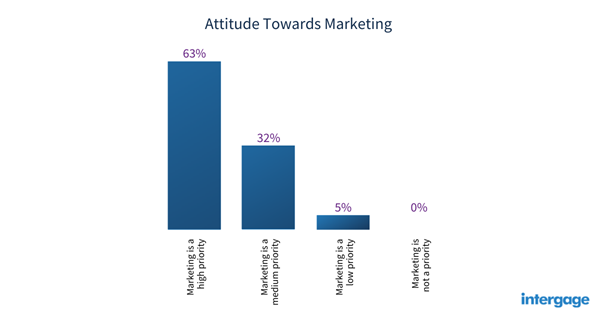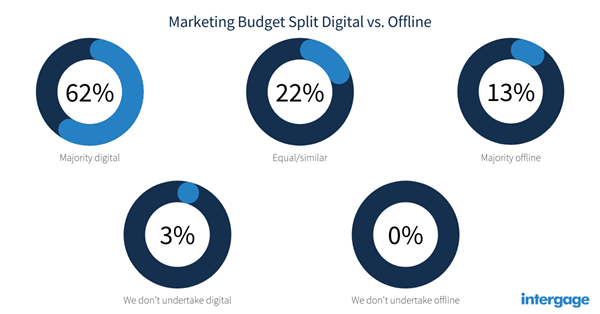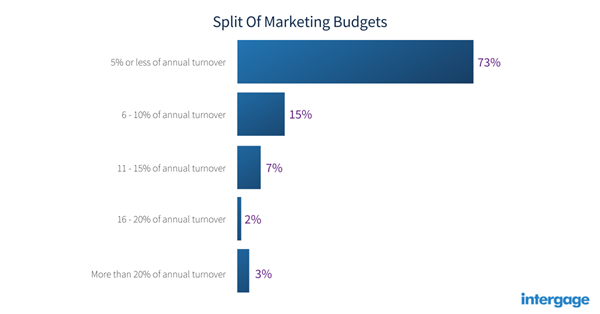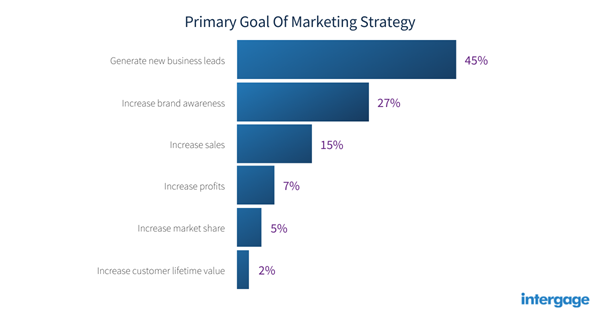The 2021 State of Marketing in Manufacturing and Engineering
As manufacturing companies emerge from the Covid storm, many will do so with a new perspective, both of their own business and the industry as a whole.
The road back to profitability will owe much to output and supply but, increasingly, marketing efforts also.
Though slow on the uptake, more operating within this key sector have come to realise promotional potential. The priority now is harnessing that.
To gauge the true state of marketing in manufacturing, Intergage recently teamed up with The Manufacturer to uncover attitudes, challenges and goals in The Marketing In Manufacturing Report.
Here’s what we discovered...
Attitudes To Marketing In Manufacturing
There has been an undeniable shift in attitudes towards marketing in the manufacturing and engineering sectors.
Somewhat old school and hands-on industries, they were perhaps guilty of shunning the digital marketing revolution. That’s no longer the case, at least not according to our findings.
Instead, perceptions of marketing are now generally very good.
63% of manufacturing businesses consider marketing a ‘high priority’. The biggest indicator of progress is the fact only 5% now deem it a ‘low priority’.

To acknowledge something however is one thing. To act on it, quite another.
That’s why it’s encouraging to note a 20% rise in manufacturing companies that can point to a documented marketing strategy as per the Content Marketing Institute Report.
More on that shortly…
Significant inroads of this kind owe much to senior management, who appear to have committed to the concept. 75% of business leaders within this field now see marketing as a ‘high priority’.
Any lingering doubts appear to reside within sales departments. We have noted that only 29% working within these teams consider marketing a high priority. Rather, 57% class it as a medium priority.
This seeming disconnect is one we’ve encountered across the industrial sectors time and time again. It can be attributed to any number of factors, but the simplest and most logical explanation is a mere difference in personalities. In short, those working in sales have a different outlook to those working in marketing.
Whereas the latter shy away from quote-carrying work, salesmen and women thrive on it. While marketers adopt conversational and strategic language, their colleagues are typically more transactional.
Different traits and personalities are fundamental to a strong collective and healthy team spirit. Even so, ensuring all buy into business goals and by extension marketing ones, is a must for B2B businesses.
Other marketing challenges include…
- Targeting the right audience.
- Creating enough content.
- Measuring success and ROI.
- A lack of marketing resource in-house.
That last obstacle would explain why 64% of industrial marketers are choosing to outsource at least one piece of content marketing activity every month (CMI).
While always important, content creation takes on added significance in this era. Why? Because 27% of the typical B2B buyer journey is now spent researching independently online (Gartner).
This places great emphasis on copywriting and ensuring your material is front and centre when relevant searches are made. It’s never been more important to share the right content, with the right people, at the right time.
That’s a big pressure on marketing teams of all sizes, particularly small ones.
Trouble measuring the success of a marketing campaign and moreover delivering a return on investment, were pain points referenced by both marketeers and salespeople surveyed. This aligns with HubSpot’s own findings, wherein 39% of marketers labelled measurement as their top challenge.
While gauging the success of traditional approaches like events and print campaigns will always prove troublesome, it’s far easier when adopting digital methods. Yes, these can be many and fragmented but investing in marketing automation systems and/or a CRM consolidates much of this, whilst painting a clearer picture on how much marketing has impacted revenue.
The clue is in fact within the name… these systems automate much of the work, lessening the burden on both sales and marketing teams.
The third biggest challenge identified in our survey was the absence of any real strategy and planning. Despite the aforementioned progress on this front, 50% of small to medium businesses are still without a formalised marketing strategy (Agility PR).
Not only that, but 86% of executive teams admit to spending less than one hour on strategy a month (OnStrategy). We talk more about that here.
This goes some way towards explaining the confusion-cum-suspicion that persists within sales teams. It’s the responsibility of business leaders to implement a plan their team can commit to.
Which Marketing Activities Are Most Successful For Manufacturers?
Analysis of marketing activities demonstrates clear evolution and a move towards a more digital offering.
Here’s the current split between online and offline marketing work…
- 62% of manufacturers say they invested the majority of their budget in digital marketing.
- 22% of manufacturers said the split was equal between digital and offline marketing.
- 13% of manufacturers said they invested the majority of their marketing budget in offline marketing.
Evidently, manufacturers and engineers are embracing digital practices, more so than ever before.

By contrast, only 18% of people now research B2B solutions offline (Gartner).
While the pandemic has no doubt accelerated this shift, it was both inevitable and logical.
So, what were the most popular marketing activities within the manufacturing and engineering sectors last year?
Social media led the way in this respect, with 83% of respondents revealing they use it. This is not wholly surprising given most companies, even in manufacturing, have some presence on the major platforms.
Content creation follows hot on its heels, with 67% of businesses investing in the likes of blogs and whitepapers. E-mail marketing of some description is utilised by 60% and there remains genuine interest in the likes of Exhibitions (53%) and speaking at Events (48%).
The biggest takeaway from these findings however is a relatively low engagement with marketing automation (22%). This is as inexplicable as it is surprising given the SMT’s State of Automation survey found 66% of those using the technology found it to be either ‘moderate’ or ‘very successful.’
Such a small take-up may go some way to explaining the drain on resource, as a great many manufacturing and engineering companies are yet to automate time-consuming tasks.
What Do Marketing Budgets Look Like For The Next 12 Months?
The next phase of our survey shed light on marketing spend, key to the success and failure of most marketing strategies.
We found that….
- 73% of manufacturing and engineering companies invest 5% or less of their annual turnover.
- 3% invest more than 20% of their turnover.

It was soon apparent that many have no clear formula for setting marketing spend.
While it may not be as simple as pulling numbers out of thin air, too few calculated how much it costs to obtain and retain customers. Metrics that should inform this decision.
In our experience, budgets should be calculated by:
- Average number of monthly leads.
- Leads to opportunity conversion rate.
- Opportunity to customer conversion rate.
- Average sale value.
- Average customer lifetime value.
It goes without saying, those in the marketing department should work tirelessly to drive the cost per acquisition down and lifetime value up, but they need a basis from which to work.
At present, too many are working without that framework.
Our survey found that 45% of respondents believe their company is currently investing enough in marketing but 20% were unsure on the returns. This again points to difficulty and uncertainty defining ROI.
Interestingly, 50% of manufacturers felt they should be spending more on marketing with 42% planning to increase spend this coming year, no doubt fuelled by the Covid bounce back.
How Do Manufacturers Measure Marketing Results?
The fourth and final part of our Marketing In Manufacturing Survey explored results and how these are categorised.
When quizzed, the majority (45%) of respondents claimed generating new business leads was their primary objective/goal.
This was somewhat predictable, so too were increasing brand awareness (27%) and sales (15%) alike.

However, only 2% considered increasing lifetime value of existing customers a primary goal. This reveals short-sightedness as too many look to fill the top of their marketing funnel, to the detriment of loyal customers lower down.
It was a similar story when exploring KPIs deployed to measure success.
78% referenced new sales, 3% web conversions and 52% a lead to sale ratio as KPIs measured.
Those numbers are far in advance of customer acquisition (17%) and cost per lead (22%), data which should shape budget and strategy combined. They feed into the idea that too few judge success by actual ROI.
Finally, Intergage asked respondents to rate their marketing performance on a scale of 1-10, 1 being the lowest.
44% scored theirs a number between 1 and 4, hinting at some degree of failure. Failure in this respect could be either one of an inability to deliver or KPIs that are too difficult to realise.
Read more about how manufacturers measure marketing results here.
To conclude, there was no shortage of findings in the first edition of The Marketing In Manufacturing Report. There remains a lack of understanding in certain areas and a distrust of certain tools, but a clear willingness to work differently and evolve.
Want to know more? Download your free copy of the full report here!






